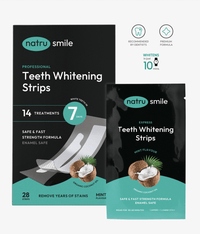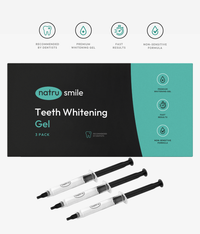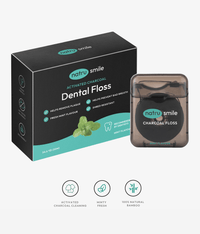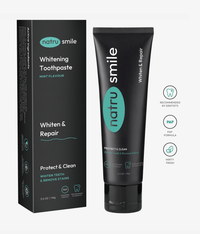
All products are certified by dental expert Dr. Greg Grillo
Taking care of your pearly whites with braces can be quite a daunting task, but it's definitely worth the effort. After all, your smile is your ultimate accessory, and you want to keep it looking fabulous both during and after your orthodontic treatment. Get ready to embark on a journey of discovering effective brushing techniques, as well as some nifty tips and tricks to maintain those dazzling braces with ease. Whether you're a newbie or a seasoned pro, this detailed guide is here to help you achieve that coveted healthy and sparkling smile.
Before diving into the specific instructions, it is important to understand why oral hygiene is especially important when you have braces. Braces, while tremendously beneficial in correcting dental alignment issues, tend to create more nooks and crannies in your mouth where food particles can get trapped. If not cleaned properly, this can lead to plaque buildup, tooth decay, gum disease, and even permanent staining – all of which can undermine the very purpose of your orthodontic treatment.
With that in mind, let's explore the most effective methods for brushing your teeth with braces and discover other essential tips to make your daily oral hygiene routine easier, more efficient, and truly "magical."
-
Select the right toothbrush: Consider using a toothbrush with soft bristles and a small head to allow for easier access to hard-to-reach areas around your braces.
-
Rinse before brushing: Swish water around in your mouth before brushing to help loosen any trapped food particles.
-
Brush at the correct angle: Position your toothbrush at a 45-degree angle against the gum line and gently brush in a circular motion. This helps remove plaque and food debris from both your teeth and your braces.
-
Clean between your brackets: Tilt your toothbrush to a downward angle to thoroughly brush the area between the brackets and the gum line. Then, tilt your toothbrush upward to clean the area between the brackets and the top of each tooth.
-
Brush each tooth individually: Spend some extra time to ensure you brush each tooth individually, focusing on the areas around the brackets and under the archwires.
-
Brush your tongue and the roof of your mouth: Don't forget these important areas, as they can also harbor bacteria.
-
Floss regularly: Use a specialized orthodontic floss threader or a water flosser to clean between your teeth and around your braces, as this will help remove any remaining particles and plaque.
-
Rinse thoroughly: After completing your brushing and flossing routine, swish water or mouthwash around in your mouth to help remove any residual debris.
- Schedule regular dental check-ups: During your orthodontic treatment, continue to visit your dentist for regular cleanings and exams, as this can help prevent dental issues and keep you on track to improve your smile once your braces are removed.
In conclusion, consistently following these tips for teeth brushing with braces on, together with oral hygiene tips for braces-wearers, will ensure that you maintain excellent oral health throughout your orthodontic treatment, resulting in a stunning and healthy smile that will truly shine once your braces come off.
Brushing With Braces: A Step-By-Step Guide
Maintaining good oral hygiene while wearing braces is essential for protecting your teeth and gums from cavities and gum disease. Although learning how to brush teeth with braces can be a bit more challenging, it's well worth the effort. Brushing your teeth is both a natural teeth whitening remedy (via the removal of damaging plaque and tartar) and one of the best preventative teeth whitening options available.
In this section, we'll break down each step involved in the brushing process when you have braces, offering clear instructions and guidance to ensure you can effectively care for your teeth while they're being realigned.
Rinse With Water To Clean Your Braces And Dislodge Food Particles
The first step in brushing your teeth with braces is to thoroughly rinse your mouth with water. By doing this, you'll help dislodge any larger food particles that may have become stuck in your braces during meals or snacks. This initial rinsing step is important because it clears the way for a more effective and comfortable brushing experience, ensuring that you're able to properly clean all the surfaces of your teeth and braces.
Choose A Toothbrush Designed For Braces And Start Brushing
Before trying to know how to brush teeth with braces, it's crucial to choose a toothbrush that's specifically designed to accommodate orthodontic appliances. These brushes typically have soft bristles, a small head that's better suited for navigating tight spaces, and a special bristle pattern that helps clean around brackets and wires. By choosing a toothbrush designed for braces, you'll not only make it easier to reach the various crevices around your braces, but you'll also reduce the risk of inadvertently damaging your orthodontic hardware during brushing.
As you commence brushing, remember to take your time and gently work the toothbrush around all areas of your teeth and braces, paying special attention to the small spaces and gaps where plaque and bacteria might be hiding.
Brush The Inner Side Of Your Teeth
When brushing your teeth, it's important to pay attention to the inner surface of your teeth - the side closest to the tongue – since most at-home teeth whitening or cleaning remedies only focus on the outside of your smile.
Start by tilting your toothbrush towards your gum line at a precise 45-degree angle. Proceed with small, gentle circular motions as you cover the entire inner side of your teeth. Make sure not to apply too much pressure; excessive force on the toothbrush can potentially damage your braces.
Brush The Crowns Of Your Teeth
It's also important to clean the crowns of your teeth, the main portion that is visible when you smile or speak. To effectively do so, press the toothbrush bristles against the top of each tooth while maintaining those small, circular motions. By focusing on these areas, you'll be better equipped to remove any food debris or plaque that may have accumulated around your braces' brackets.
Clean Your Braces And Brush Each Wire
Cleaning both your braces' brackets and the connecting wires is essential to prevent plaque buildup and maintain good oral hygiene. To assist with this, use an orthodontic brush for braces, or an interdental brush for braces. Gently, yet thoroughly clean around your braces' brackets, as well as the wires, using caution to not cause any damage to your braces (especially if they’re softer gold braces).
By following these dental care steps, you can ensure your teeth and braces stay clean and healthy throughout your orthodontic treatment. Remember to also schedule regular appointments with your orthodontist to monitor your progress and address any potential issues in a timely manner.
How To Effectively Clean Between Your Teeth With Braces
Keeping clean teeth with braces can certainly be a difficult and frustrating task, but it's crucial to maintain proper oral hygiene to prevent gum diseases, cavities, and other complications. In this section, we'll delve into a variety of helpful tips and techniques that will simplify the process of cleaning your teeth when braces are present.
Give Water Irrigators A Try
Water flossers, also known as oral irrigators, use a concentrated and powerful water jet to systematically clean between your teeth and around your braces. These clever devices have a significant advantage over traditional flossing methods, as they can more easily reach and clean those hard-to-access areas. In addition, oral irrigators are typically easy to operate and can often lead to faster, more efficient cleaning sessions.
Incorporate Mouthwash Into Your Routine
Using an antimicrobial mouthwash after brushing and flossing is another valuable technique for maintaining pristine oral hygiene when braces are involved. Mouthwash offers several benefits: it helps eliminate bacteria that may be lingering between your teeth, further cleans those tough-to-reach spots, and helps to reduce bad breath. Moreover, incorporating mouthwash into your daily routine can also help to limit inflammation in your gums, ultimately promoting overall oral health.
That said, don’t just rely on mouthwash to keep your smile fresh and white. Whether via natural teeth whitening or routine dental visits, make sure you’re going above and beyond for the optimal smile.
How Long Should You Brush Your Teeth With Braces? A Comprehensive Explanation
When teaching people how to brush teeth with braces, dentists strongly recommend that such individuals should brush their teeth for two to three minutes each time, in order to thoroughly clean every surface of their teeth and orthodontic appliances. This is a slightly longer duration than the average person without braces needs, and it's essential to maintain this diligent oral care to avoid potential dental issues.
In addition to brushing twice daily, it is crucial to brush your teeth after every meal, and if possible, after consuming snacks as well. This extra effort is necessary to remove trapped food particles that can easily get lodged in between your braces and teeth, preventing plaque buildup and potential decay.
Consequences Of Not Brushing Your Teeth With Braces
Neglecting to brush your teeth while wearing braces can lead to a host of dental problems, some of which can have long-term effects on your oral health. These issues may include cavities, which can form as a result of trapped food particles and the buildup of bacteria; gum diseases such as gingivitis, which can be caused by inflammation and infection of the gums; and decalcification, which results in the formation of unsightly white spots on your teeth due to a loss of minerals.
Moreover, failure to maintain proper oral hygiene when undergoing orthodontic treatment can cause unpleasant bad breath or halitosis, which can negatively affect your social life and overall well-being. More importantly, not brushing your teeth properly during your orthodontic journey can significantly increase the time it takes to achieve the desired results, which means you'll have to wear your braces for a longer period and possibly face additional brace costs for extended treatment.
Therefore, for those with braces, maintaining a disciplined oral care routine, including brushing for at least two minutes each time, is crucial to ensure optimal dental health and to achieve the best possible outcome from their orthodontic treatment. Choosing the right brace color can help with this – some people prefer making their colors as bright as possible, to help improve visibility in case something gets stuck.
Can I Use A Normal Toothbrush For Braces?
While it's possible to use a regular, soft-bristled toothbrush for brushing when you have braces, it might not be the most effective option for keeping your teeth and braces clean. The standard toothbrush may struggle to thoroughly clean around the brackets and wires that are typical components of braces.
For optimal cleaning and hygiene, choosing a toothbrush specifically designed for braces, such as a V-trim orthodontic toothbrush, is highly recommended. These specialized toothbrushes feature unique bristles that can more effectively clean around the various orthodontic components, ensuring better dental hygiene maintenance during your treatment period.
How Many Times Should I Brush My Teeth With Braces?
When you have braces, the recommendation for brushing frequency increases compared to those without orthodontic devices. Ideally, you should aim to brush your teeth after each meal and after consuming any snacks. This diligent routine will help eliminate food particles that may become trapped within the braces, greatly reducing the risk of plaque buildup, cavities, and gum issues during your orthodontic treatment.
At the very minimum, brushing your teeth twice a day – in the morning and at night – is essential. However, it's important to keep in mind that incorporating more frequent brushing sessions into your daily routine will greatly enhance your oral hygiene, ensuring that your teeth and gums remain in optimal condition throughout your orthodontic journey.
Can I Use An Electric Toothbrush To Brush My Teeth With Braces?
Absolutely! Electric toothbrushes can be used effectively for cleaning your teeth while wearing braces, as long as you're gentle and utilize a brush head specifically designed for braces or a sensitive, soft-bristled brush head. Using the right brush head ensures that the bristles can navigate around the brackets and wires without causing any damage.
Are Electric Toothbrushes Safe For Braces?
Yes, electric toothbrushes are safe to use for those wearing braces, as long as you're gentle and use the appropriate brush head. Electric toothbrushes can provide a more thorough cleaning than manual toothbrushes, thanks to their advanced technology and features, such as oscillating, pulsating, or sonic movements.
When using an electric toothbrush with braces, ensure that you don't apply too much pressure, as this can potentially damage your braces or bend any wires. Instead, hold the toothbrush lightly against your teeth and let the brush do the work, moving it slowly around your mouth to clean all the surfaces, including the areas around brackets and wires.
As long as you're mindful of the pressure and use the right brush head, an electric toothbrush can be a helpful tool in maintaining oral hygiene with braces. Moreover, some electric toothbrush manufacturers offer special brush heads designed for orthodontic care, which can further ensure that your braces are safe and clean during use.
Can I Brush My Teeth With Braces Only Once A Day?
When it comes to brushing your teeth with braces, limiting yourself to only once a day is generally not sufficient to maintain proper oral hygiene. Dental professionals recommend brushing your teeth a minimum of twice a day to prevent plaque buildup, cavities, and gum diseases. However, the ideal approach would be to brush after every meal, which ensures removing food particles trapped around the braces and between your teeth, thus promoting better oral health.
Braces make it easier for food particles and plaque to accumulate in hard-to-reach areas, which can eventually cause various oral health issues. Therefore, being proactive in your oral hygiene while wearing braces is vital in maintaining a healthy and beautiful smile throughout your orthodontic treatment and beyond.
Is It OK To Not Floss With Braces On?
Although flossing may seem more challenging with braces, it's important not to forego this essential step in your dental care routine. Choosing to neglect flossing while wearing braces can result in plaque buildup, cavities, and gum diseases, which can negatively impact your overall oral health.
Properly flossing with braces requires extra effort and may take longer than normal, but it's crucial for preserving your teeth and gum health. Special orthodontic floss, floss threaders, or interdental brushes can make the process easier and more effective.
In summary, flossing is indispensable during orthodontic treatment. It's essential to invest the necessary time and effort to ensure the best possible results from your braces and maintain a healthy, attractive smile.
How Much Brushing Is Too Much With Braces On?
When it comes to brushing with braces, maintaining proper oral hygiene is crucial, but can there be such a thing as brushing too much? The answer is yes. Brushing your teeth more than four times a day might be considered excessive and can potentially lead to gum irritation or tooth enamel wear. To strike the right balance, we recommend brushing after each meal (which typically averages about three times daily) and, if needed, following the consumption of snacks. This approach will help you maintain proper oral hygiene while also reducing the risk of damaging your teeth and gums during your braces treatment.
How Do You Know If You're Brushing Well With Braces On?
Ensuring you're brushing effectively with braces is essential for maintaining a clean, healthy mouth. To help you gauge whether you're doing a good job, observe the following signs:
-
Food particle and debris removal: Your teeth and braces should appear clean without visible traces of food particles or debris. Ensuring their removal helps keep plaque and potential bacterial growth at bay.
-
Healthy gums: Your gums should have a pinkish hue and remain pleasant to the touch without being red, swollen, or bleeding. Inflammation could be an indication of improper brushing technique, over-brushing, or another issue.
- Fresh, clean breath: A clean and fresh-smelling breath is another sign of good oral hygiene with braces. Persistent bad breath might indicate a need to re-evaluate your brushing technique or frequency.
If, despite following the above guidelines, you still find yourself uncertain about your brushing technique or need extra reassurance, don't hesitate to consult your orthodontist or dentist. They can assess your technique or propose tailored solutions to help ensure that you're practicing proper oral hygiene during your braces treatment. As they can check with you your current condition, they are the ones who can properly guide you on how to brush teeth with braces.










